Shopify Market Share and Usage Statistics
Global ecommerce had a record year in 2020: Closures and restrictions forced businesses to evolve and adopt an online model. Worldwide ecommerce sales in 2020 grew by 25.7% to $4.2 trillion and are expected to hit $5.5 trillion in 2022.
Put simply, there are plenty of ecommerce sales opportunities, and everyone wants a piece of this delicious pie.
The great thing about the ecommerce boom is that it’s now simpler to start an ecommerce store. There are many different ways to do so. You can:
- Build a custom WordPress ecommerce store
- Sell via ecommerce marketplaces like Amazon and eBay
- Use ecommerce platforms like Shopify or BigCommerce
In this guide, we’ll focus on Shopify. Shopify is an ecommerce solution that lets you start an online store in 10 minutes or less.
With Shopify, you can sell on:
- Social media platforms like Facebook, Twitter, Instagram, Pinterest, TikTok, WhatsApp, and Messenger
- Sales channels like Amazon Marketplace, eBay, Etsy, and Google Shopping
- Your online and physical stores
Since its inception, Shopify’s market share has continued to increase due to its simplicity, versatility, and ease of use. Let’s dive into that and more.
Shopify 411
Shopify is a software-as-a-service (SaaS) platform that lets you start, grow, and manage an online store. It was started in 2006 by Tobias Lütke, Daniel Weinand, and Scott Lake in Ottawa as they attempted to open an online store for snowboarding equipment. It took Lütke, a programmer by trade, two months to build an online store on his own using Ruby on Rails — and the rest is history.
Now, Shopify is listed on the New York Stock Exchange (NYSE) and Toronto Stock Exchange (TSE). The initial public offering (IPO) occurred on May 20, 2015, and began trading on May 21, 2015.
Shopify’s business lines include subscriptions, payments, point of sale (PoS) hardware, and even loans.
Shopify has also branched into the physical retail space by opening its first brick-and-mortar storefront in LA in 2018 and entrepreneurial space in New York’s SoHo neighborhood in 2021.

Headquartered in Ottawa, Shopify powers ecommerce websites in 175 countries, supports 20+ languages, and employs over 10,000 people.

Shopify is trusted by established brands such as Nestle, Pepsi, and Unilever. Besides that, popular lifestyle and beauty brands like Kylie Cosmetics, Vogue, and Gymshark also use Shopify.
Shopify Plans, Themes, and Apps
Part of what makes Shopify popular is its affordable subscription model.
When users subscribe to a plan, they get all the functionality they need to start an ecommerce store — without the need for coding know-how. Also, users can subscribe, upgrade, downgrade, and cancel their plans anytime they want.
Shopify’s pricing plans start at $29/month for new and growing businesses, whereas established businesses can use dedicated plans starting at $2,000/month called Shopify Plus.
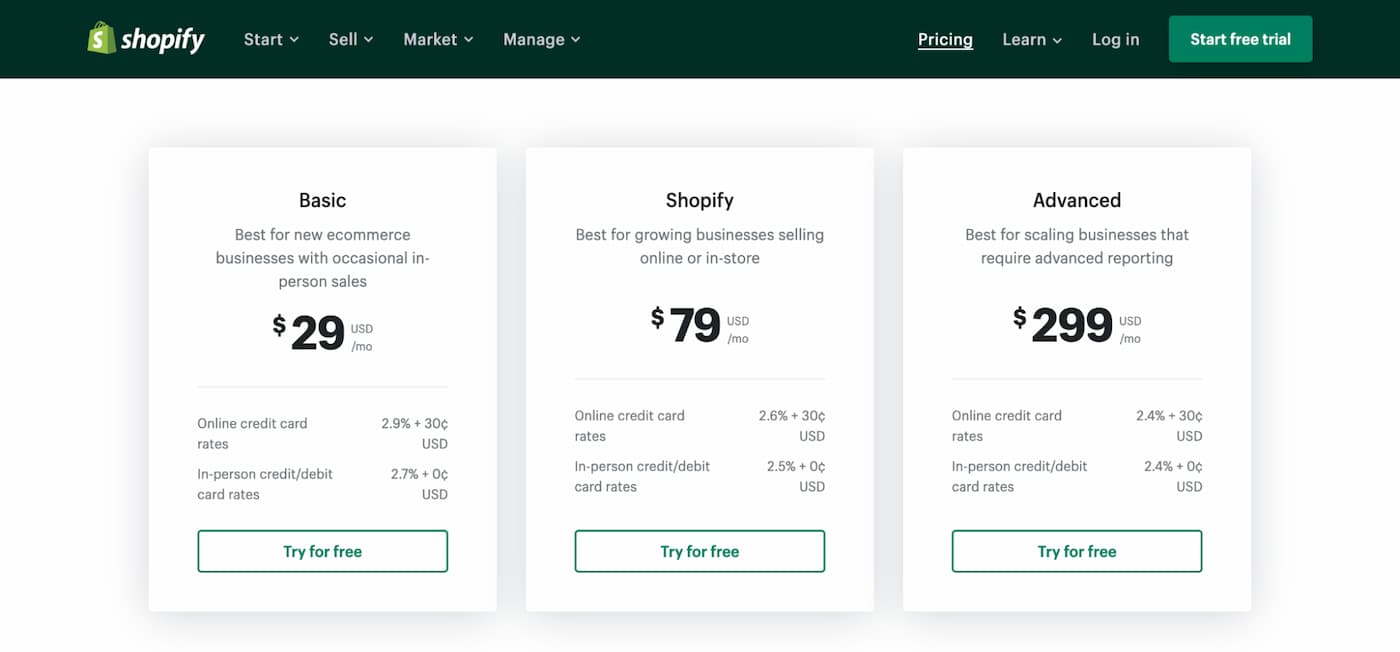
Another thing users like about Shopify is that you can customize your online store using apps and themes.
The Shopify App Store features 8,000+ apps. Product Reviews, Klaviyo, and Shopify Inbox are the top three apps store owners use, according to Store Leads.
On the other hand, the Shopify theme store has 90+ free and paid themes, which gives you plenty of choices.
Ecommerce Platform Market Share
According to BuiltWith, as of June 2022, 25.5% (or 255,577) of the top 1 million live websites worldwide (by traffic) are ecommerce websites. Of those websites, 20% were powered by Shopify, second after WooCommerce.
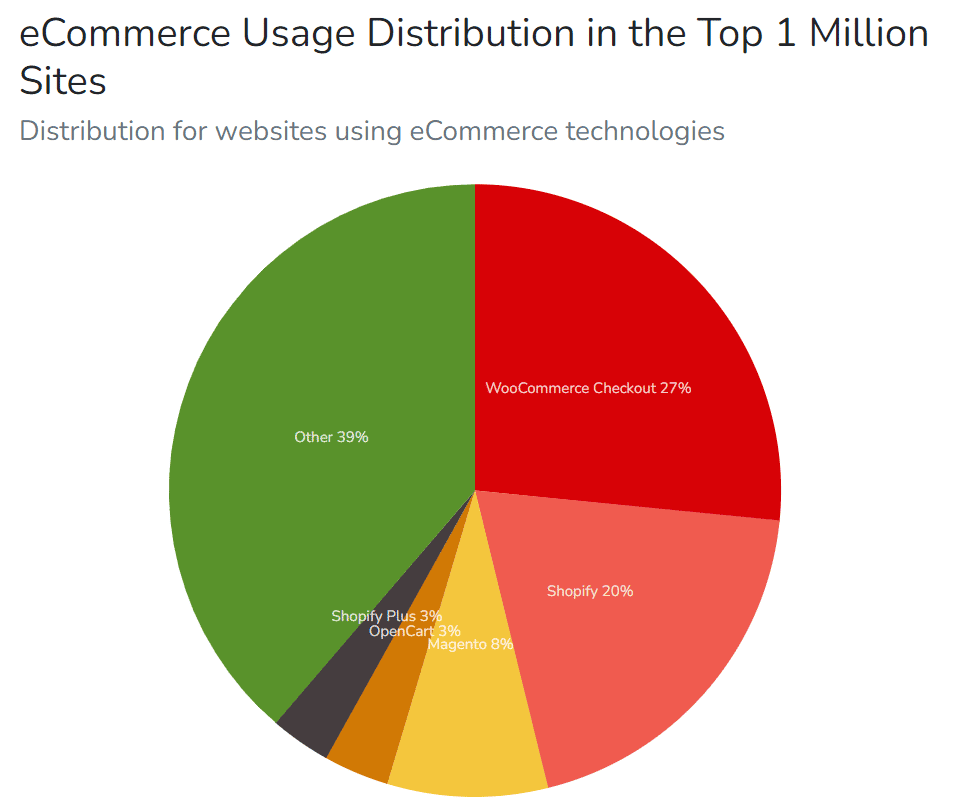
Here is a breakdown of the top websites (worldwide) using Shopify:
- 400 out of the top 10,000 websites
- 2,548 out of the top 100,000 websites
- 20,422 out of the top 1 million websites
Shopify Market Share in the US
According to BuiltWith, as of June 2022, there are over 26.2 million ecommerce websites worldwide, with 9.2 million websites (or 36.4%) coming from the U.S. (BuiltWith’s data does not include China).
The United States, the United Kingdom, Australia, Germany, and Brazil are in the lead as the top five countries with the most ecommerce stores.

When it comes to Shopify, the U.S. is its biggest market with a 66.8% share. Besides that, Canada, which Shopify calls its home, also appears in the top five.
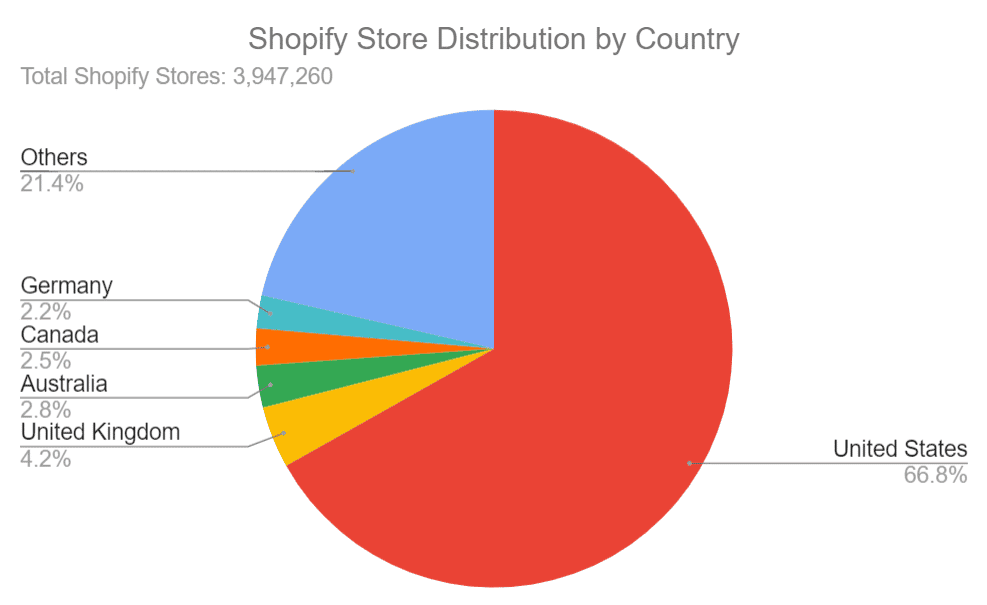
Of the 9.2 million ecommerce websites in the U.S., 28.51% (or 2.6 million) use Shopify. Most of these stores are located in California, with over 70,000 businesses using Shopify as their preferred ecommerce platform. New York and Florida come in second and third place, home to approximately 31,000 and 27,000 Shopify customers, respectively.

However, Shopify’s market share percentages change when you consider gross merchandise volume (GMV), or the total value of items sold on a platform.
In terms of GMV, Shopify claims a 10.3% market share in the U.S. — a distant second behind Amazon. But its market share still comes out to be a little less than Walmart and eBay combined.

Shopify Market Share in Other Markets
While Shopify dominates the U.S. ecommerce market, it struggles to make its presence count in the rest of the world.
China is still the largest player in the global ecommerce market, generating 52.1% of retail ecommerce sales worldwide (versus the U.S.’s 19%). Fueled by China, the Asia Pacific region is the largest market for retail ecommerce, with digital sales amounting to nearly $3 trillion in 2021.

This information tells us that there is a bigger world outside the U.S. ecommerce space — and not all of it uses Shopify. A steady increase in Shopify’s market share in the other top ecommerce markets would propel them further.
According to Shopify’s Annual Year-in-Review report, more merchants globally launched and started growing their businesses on Shopify in 2021 than before.
Most of the new merchants still came from the North American market (55%), but Shopify reports that they increased their mix of merchants outside North America. These merchants also grew their sales faster than those in North America.
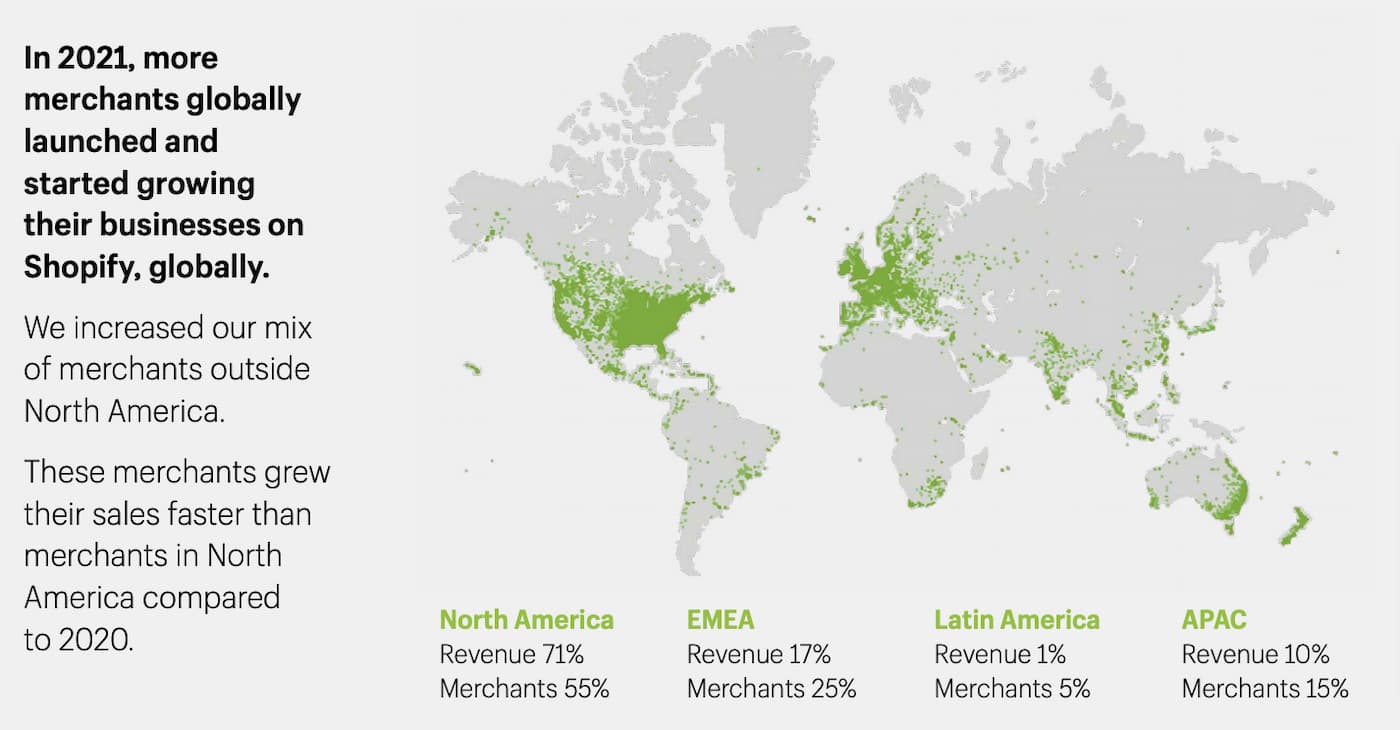
If Shopify wants to grow in markets outside North America, it should look out for expansion in India, Brazil, and Argentina. eMarketer’s 2021 Global ecommerce report tags these countries as the fastest-growing ecommerce markets. It expects retail ecommerce sales in these markets to grow by at least 26% in 2022.
Shopify Plus Market Share
Shopify Plus is the platform’s dedicated plan for enterprise users.
As of June 2022, there are 26,344 domains on Shopify Plus. Out of those, 17,562 are distinct merchants. (Shopify Plus enables merchants to operate stores on multiple domains).
From 2021 to 2022, there was a 31% YoY increase in Shopify Plus users. Moreover, in Q1 2022, Shopify Plus contributed $31.8 million (or 30%) of Shopify’s MRR, up from 26% from the previous year.
Shopify: Popular Niches
Let’s explore what’s trending on Shopify.
According to the Store Leads App, popular niches on Shopify as of June 2022 include:
- Apparel (28.1%)
- Home and Garden (10.6%)
- Beauty and Fitness (9.9%)
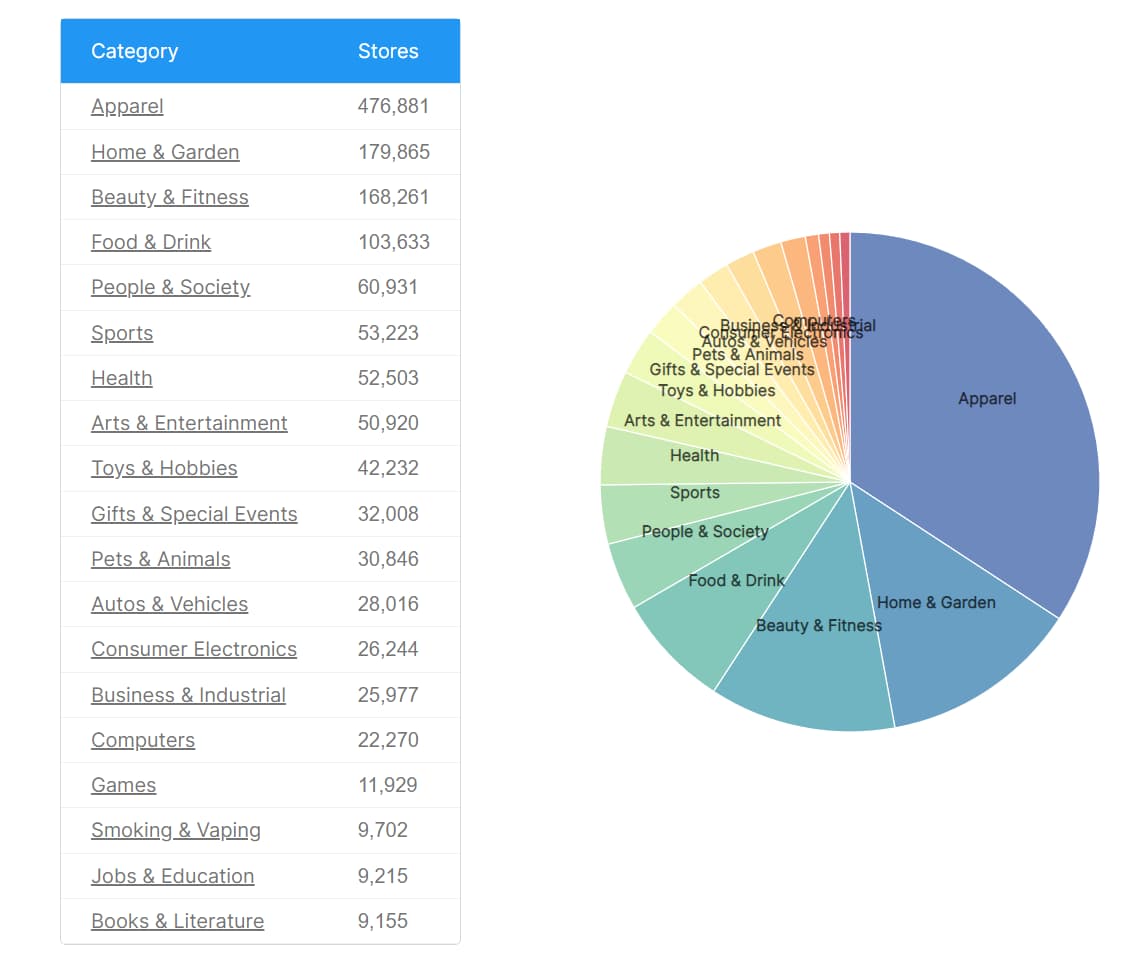
Traffic Sources
According to the 2022 DataReportal report, accessing a website directly (27%) is the most popular way visitors reach ecommerce websites, followed by:
- Organic SEO (22%)
- Paid search ads (19%)
- Links embedded in emails (5%)
- Paid social ads (4%)
- Organic social posts (1%)
Meanwhile, Similarweb* shares that most of Shopify’s pageviews (40.15%) come from direct traffic, followed by:
- Organic search (27.34%)
- Referral traffic (26.73%)
- Social networks (2.56%)
- Links embedded in emails (2.27%)
- Paid ads (0.95%)
*Similarweb data only considers desktop visits.

Shopify isn’t limited to domestic shoppers. In July 2021, over 27% of all traffic to Shopify stores came from international buyers.
Also, you shouldn’t ignore your ecommerce store’s mobile performance. During Black Friday weekend 2021, 71% of Shopify sales were made on mobile devices, with only 29% on desktops.
Make sure to get a reliable and performance-focused hosting solution that helps you optimize your ecommerce website for mobile.
Audience Demographics
What about Shopify’s demographics? Let’s find out:
- Almost 60% of Shopify’s audience is male, while the rest is female.
- One-third of Shopify’s audience falls between the 25–34 age bracket demographic.
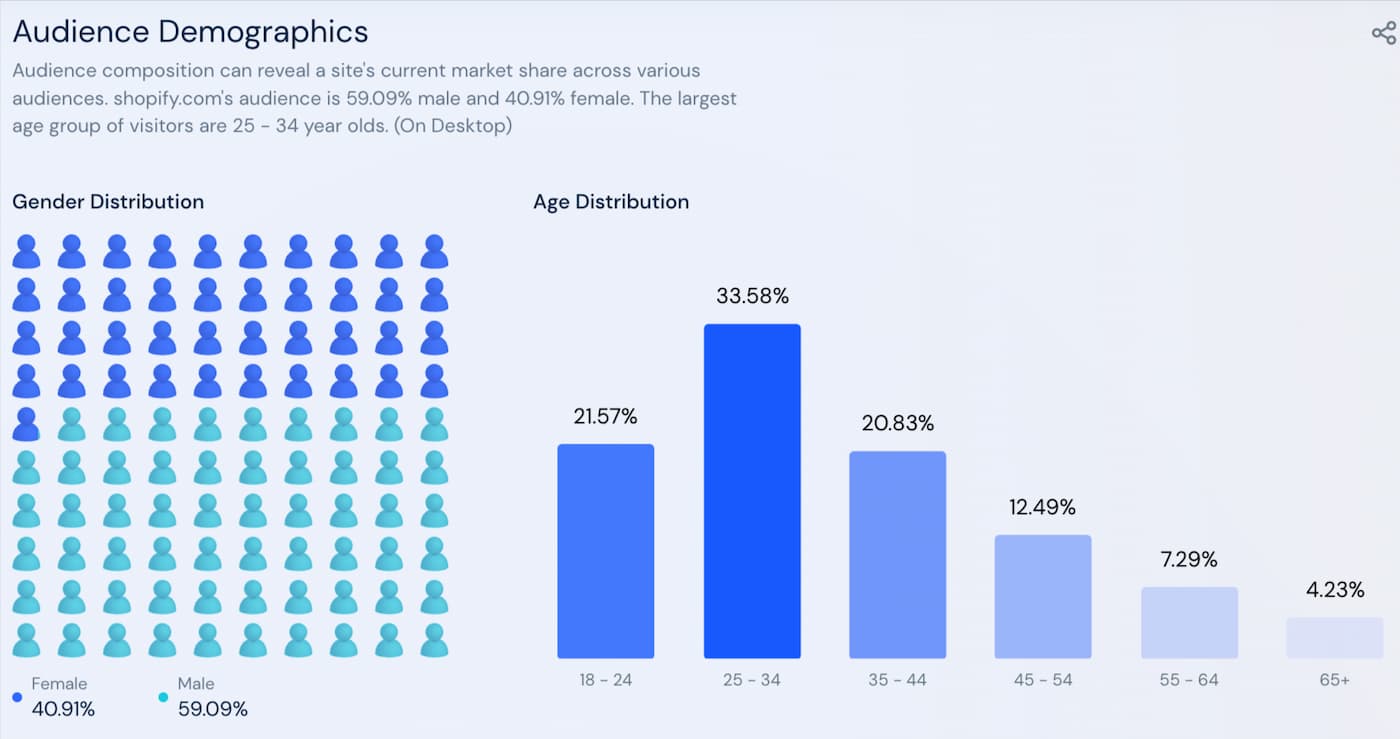
Growth and User Acquisition
Shopify emerged as one of the COVID pandemic’s biggest winners. As an infrastructure provider, it enabled store owners to set up their ecommerce shops quickly and became one of the fastest-growing online store builders during the lockdown.
According to Genus AI, the number of ecommerce websites rose by 201% from March 2020 to January 2022.

Particularly, Germany experienced a Shopify boom with a growth rate of 480% in that same period.
In addition, Shopify merchants had over 457 million buyers by the end of 2020, which increased by 31% to 597 million buyers at the end of 2021.
Shopify acquires its users in multiple ways — particularly through referral and affiliate programs:
- In 2020, 42,200 partners referred a merchant to Shopify, 72% higher than 24,500 in 2019.
- Members of the Shopify affiliate program can earn an average of $58 per user that signs up for a Shopify paid plan.
- Shopify also gains users when they transfer from competitor websites. According to Store Leads, 13,794 online stores (mostly WooCommerce and Wix) switched to Shopify from May 2022 to June 2022.

The opposite also happens.
During the same interval, 13,313 online stores switched from Shopify to its alternatives. Most users switched from Shopify to WooCommerce and Custom Cart.
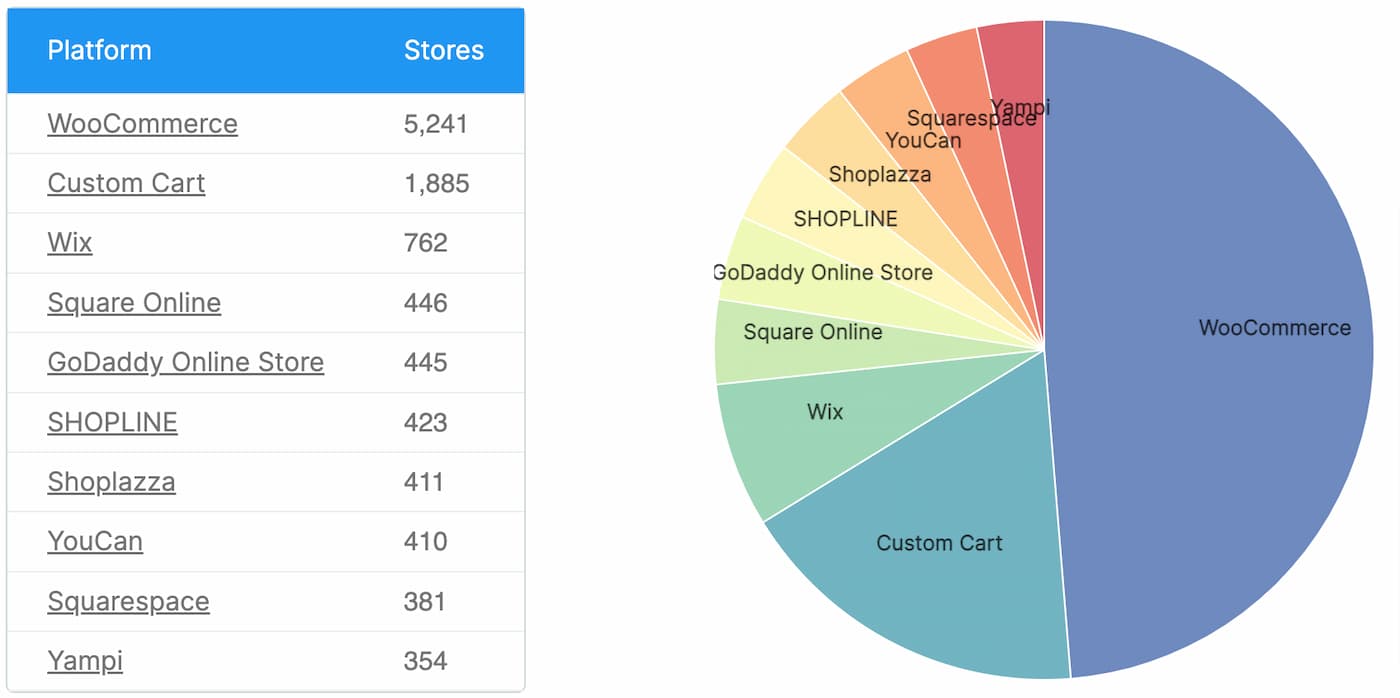
Shopify: Sales and Revenue
2021 was a fruitful year for Shopify.
Although Shopify surpassed $1 billion in gross merchandise volume (GMV) in 2013, it achieved its first billion-dollar revenue quarter in Q2 2021.
Shopify processed $175 billion in online sales in 2021 — 47% higher than in 2020. From those sales, Shopify earned a total revenue of $4.6 billion (57% higher than in 2020).
As per Shopify’s financial reports for the first quarter of 2022:
- Their total revenue grew to $1.2 billion, representing a two-year compound annual growth rate of 60%.
- Monthly Recurring Revenue (MRR) was $105.2 million, representing a 17% increase year-over-year (YOY).
- Shopify Plus contributed $31.8 million (or 30% of the MRR — up from 26% in 2021).
- GMV was $43.2 billion, representing a two-year compound annual growth rate of 57% and an increase of $5.9 billion, or 16%, over Q1 2021.
Since most of Shopify’s users come from the U.S., most of its revenue comes from the U.S. as well. Shopify generated $2.15 billion from sellers located in North America in 2020, totaling 73.3% of overall revenue.
User Revenue
Let’s dive into what you can earn by opening a Shopify store:
- Shopify store owners can make between $1,000 and $100,000 per month, depending on the traffic and the type of products they sell.
- Shopify users can expect to earn an average of $72 per buyer. Low-earning stores have an average order value (AOV) of $44, while high-performing ones have an AOV of $149.
And you can further increase your profits by optimizing your store for upcoming mega sales:
- Shopify merchants made $6.3 billion in global sales during 2021’s Black Friday to Cyber Monday weekend, representing a 23% increase compared to 2020’s Black Friday weekend.
- Peak sales reached $3.1 million per minute on 2021’s Black Friday.
Global AOV increased to $100.7, with consumers in Canada (115.14 CAD), Australia (158.80 AUD), and the U.S. ($96.60) spending the most on average.
Shopify Market Share: A Look at the Popular Ecommerce Platform
Ecommerce isn’t going anywhere.
Whether you’re a business owner or budding entrepreneur, it’s never too late to launch your ecommerce store.
Beginners can start by creating a Shopify store, which lets you build an ecommerce store in minutes. But as your business’s needs grow and you come to require more control over your platform, moving your store to WooCommerce is your best bet.
WooCommerce comes from the same parent company as WordPress. Its open-source nature lets you set up your online store on any hosting platform. What’s more, you can modify your WooCommerce website any way you see fit, with thousands of easy-to-install plugins and stylish themes to extend your website’s functionality.
When you’re ready to create a WooCommerce store, sign up for Kinsta WooCommerce hosting.